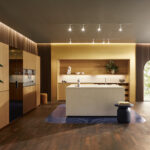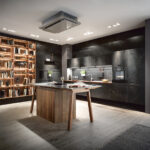Your kitchen is one of the most important rooms of your home. It’s where you cook, eat, and even entertain, so you naturally want this space to feel luxurious. Whether you’re planning a new kitchen from scratch or just want to refresh your existing space, it can be tricky to know where to start. How do you create a kitchen that suits your style and includes everything you need it to?
If you’re planning a remodel and you’re wondering how to design a kitchen, the experts at InHouse Inspired Room Design are here to help. We’ve put together our top tips which include everything from planning a kitchen layout to choosing your kitchen furniture, so you can get started on creating a space that works for you. Follow our checklist below and you’ll be in your brand-new dream kitchen in no time.
- List your essentials
- Decide on a budget
- Design your layout
- Follow building regulations
- Choose your kitchen
List your essentials

The first step to planning a new kitchen is listing your must-haves. Is there anything your kitchen doesn’t currently have that would be key to your new design, such as extra cupboard space, an entertaining area, or even a few luxuries like a coffee machine and pantry? Of course, you should also consider the opposite — do you currently have any unused features that are taking up precious space? Deciding early on in the planning stage what you need (and what you don’t) can help you design a kitchen that fits around your lifestyle.
Don’t be afraid to think big at this stage. The design process is all about figuring out what your dream kitchen looks like. But, at the same time, it’s important to be logical as well. It may be helpful to create an essentials list and a ‘nice to have’ list. This way, you can remove anything non-essential if it doesn’t quite fit into your plan or budget.
Decide on a budget
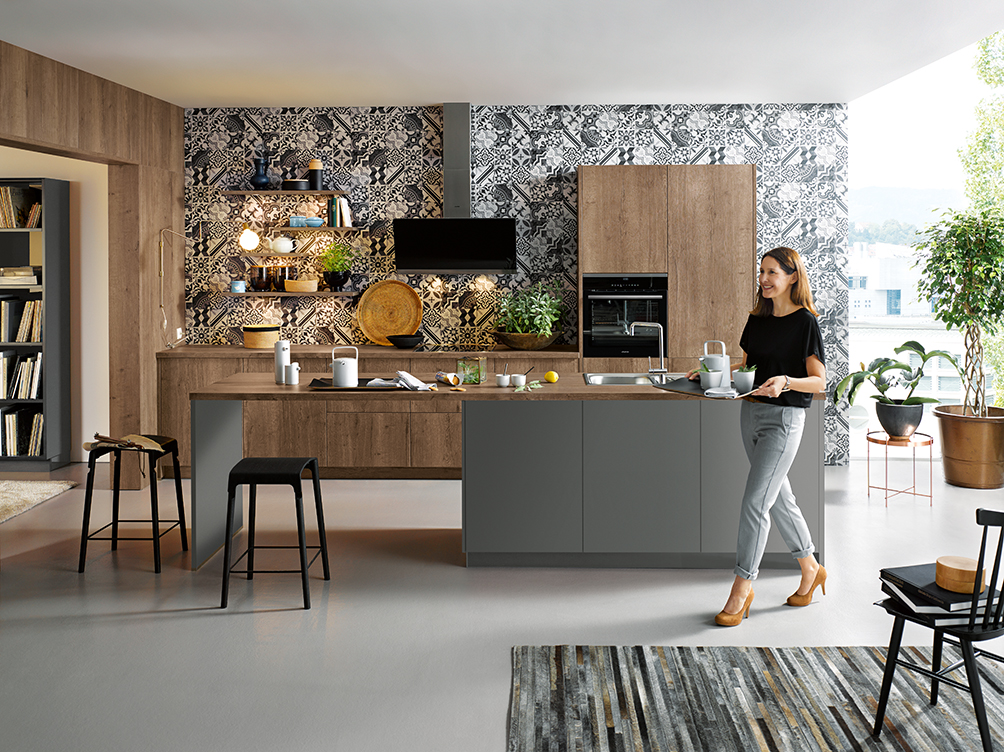
After creating your list, your next step is to decide on a budget. This will help you figure out what you can reasonably afford to include in your kitchen design — and where to spend your money.
For example, if your budget is small, you may want to invest in just the essentials, such as new cabinetry, worktops, backsplashes and recesses, and flooring, but keep the rest of your appliances and fittings, such as your sink. According to Checkatrade, new kitchen units can set you back around £10,000, while a full renovation could cost between £11,500 to £35,000. So, choosing just the essential renovations is a great option if you’re working with a modest budget.
If you’re planning on spending a little more, then you may be able to invest in the details, such as higher quality materials, as well as change appliances and fittings. For particularly high budgets, then more major layout changes could be an option, such as building an extension or going open plan.
Some design experts suggest sticking to the 5–15% rule. This states that your minimum spend should be 5% of your property’s current value, and no more than 15%, in order to get a good return on investment if you ever decide to sell your home. Of course, if you know you’ll be living in your home for a long time yet, then you can choose to expand your budget to create the perfect kitchen for your lifestyle.
It’s also a good idea to break your costs down into more manageable expenses. We’d recommend the below breakdown as a general guide, but feel free to change your budget to suit your needs and your kitchen plan.
- Cabinets: 30%
- Worktops: 20%
- Appliances: 20%
- Walls and flooring: 10%
- Plumbing: 5%
- Electrics: 5%
- Labour: 10%
As with any home improvement project, unexpected costs can occur as the work progresses. So, it’s a good idea to add an extra 10% contingency budget to cover things like delivery costs, planning permission, and so on.
Design your layout
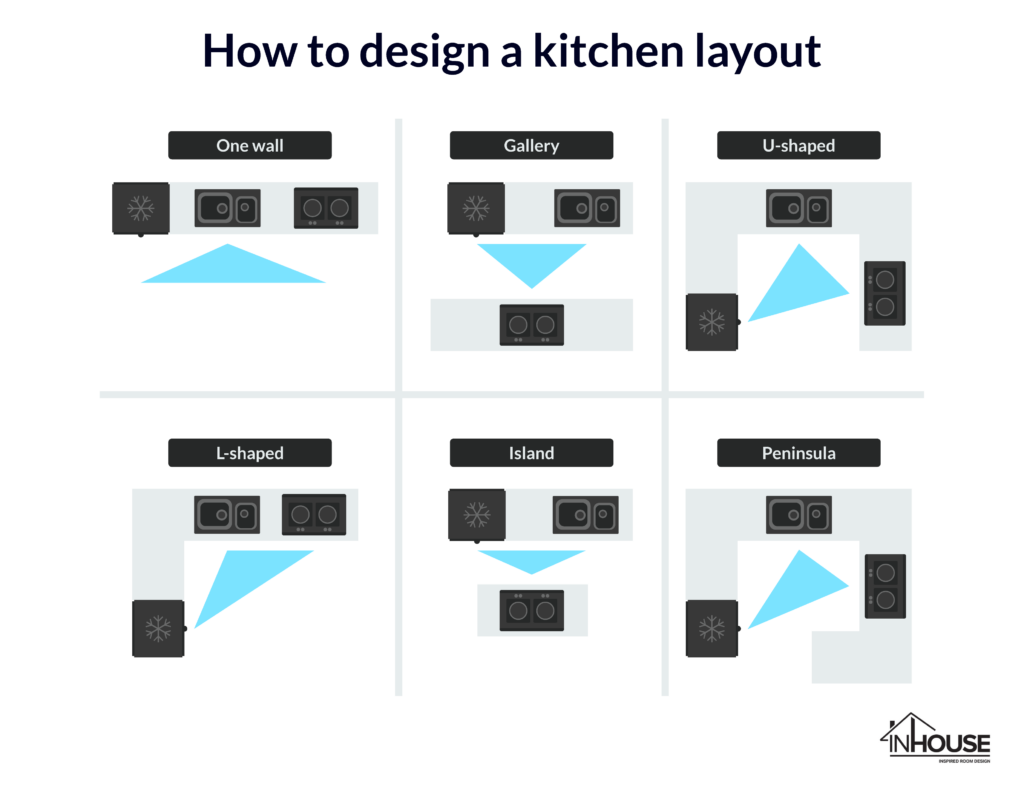
Once you’ve narrowed down your essentials and budget, it’s time to start planning where everything will go. How you plan your space can entirely depend on the shape of your kitchen, but there are some fundamentals that you may want to bear in mind when designing a kitchen.
No matter the shape or size of your room, it’s a good idea to consider exactly how you use the space. This will help you plan your most efficient kitchen layout. Think about which areas of your kitchen you’ll be using the most and how you’ll move between them. Designers call this the kitchen triangle method, which involves placing the vital elements of your kitchen — the cooker, fridge, and sink — in a triangle. Using this as a starting point ensures that your kitchen looks great and is functional too.
It’s also worth bearing in mind the position of any tall appliances or cabinetry. Due to their size, these often look best sitting at the end of a run of cabinets. Placing them here ensures a seamless flow between the rest of your workstations.
When designing a kitchen layout, the shape and size of your space can also play an important role. There are six main kitchen layouts:
One-wall kitchen
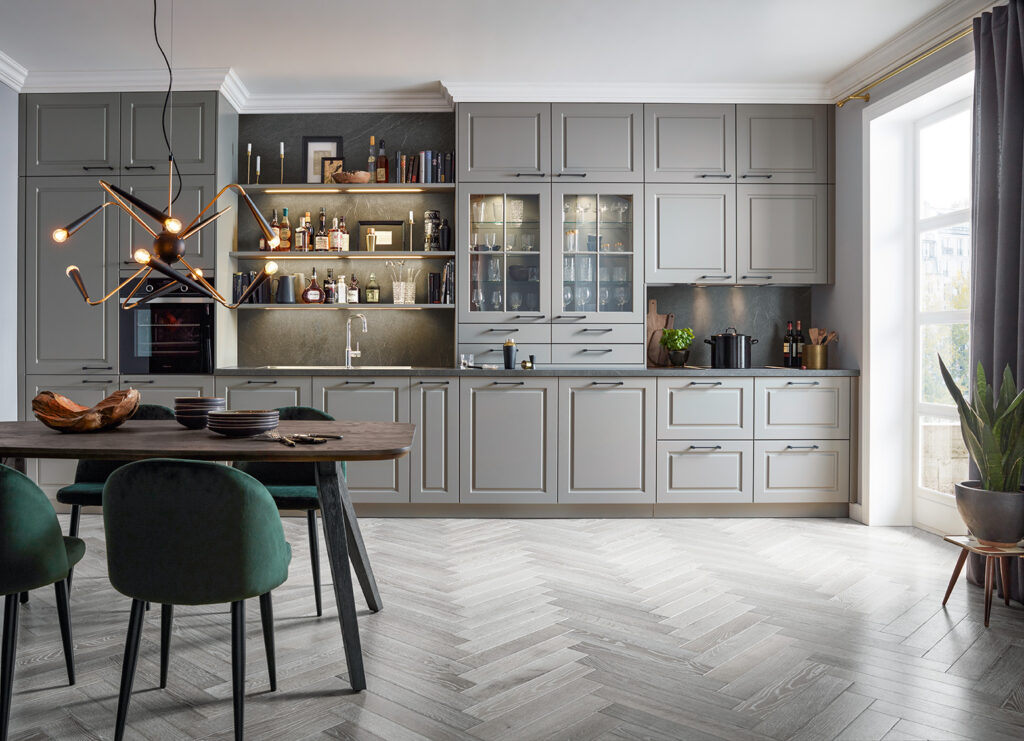
As the name suggests, a one-wall kitchen, also called a single line kitchen, houses all cabinetry and appliances on one wall. Thanks to the simplicity of the design, these kitchens can be cheaper to install. They also make perfect options if you’d like to keep the majority of your space free for other features, such as a living or dining area. However, they can also be quite compact, so aren’t the best choice if your kitchen tends to get busy.
Galley kitchen

A galley kitchen is perhaps one of the most popular kitchen layouts. Named after the small cooking spaces aboard ships, this style of kitchen has two runs of cabinetry on either side of the kitchen, with a narrow space in between. To give you enough room to do your tasks and open cupboards fully, the corridor between a galley kitchen should be at least 1.5 metres wide. Due to its shape and space-saving qualities, a galley layout is perfect for smaller kitchens.
U-shaped kitchen

The U-shaped layout is similar to that of a galley kitchen, but includes three walls of cabinetry instead of two. Again, this is a great option for compact spaces, and those with larger kitchens may go for a U-shaped layout with a kitchen island in the middle. This layout is also one of the most efficient and there’s plenty of storage space, making it perfect for multitasking and large families.
L-shaped kitchen
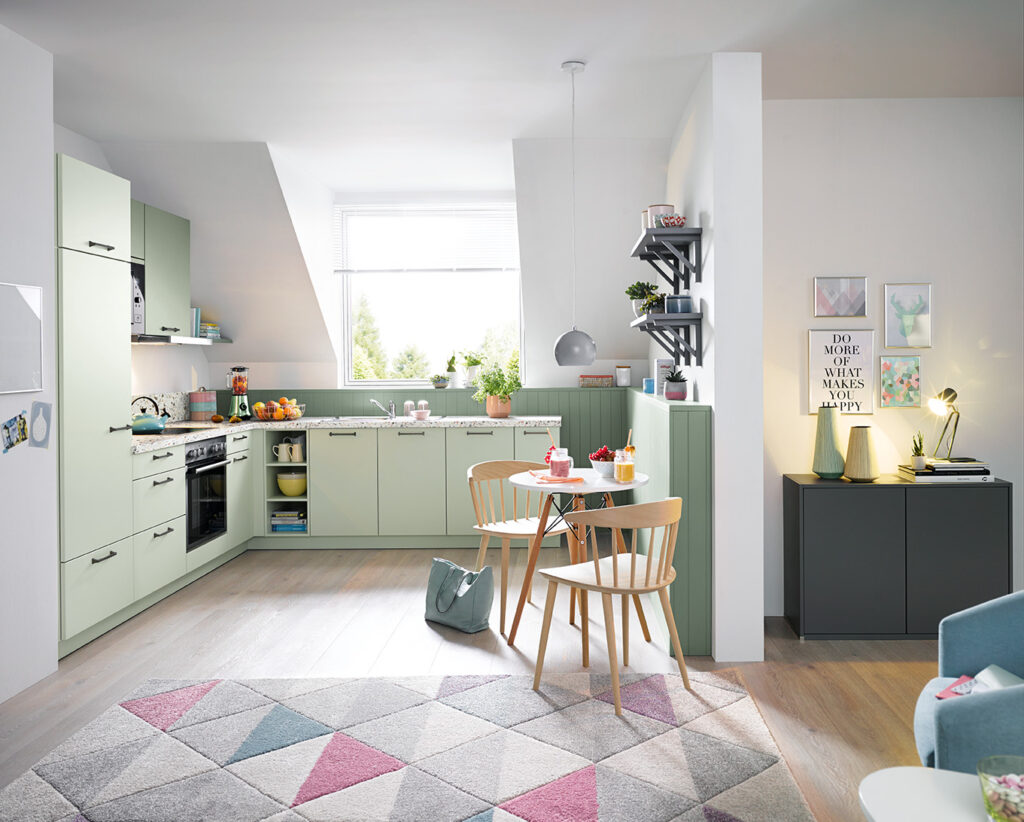
An L-shaped kitchen has two runs of worktops on adjacent walls, which meet in one corner to form an ‘L’ shape. This type of kitchen is perfect for smaller spaces, as it can create a more open feel not seen in traditional galley and U-shaped kitchens. This layout is also ideal for an open plan living area as the spacious design can feel inviting and sociable. Again, the L-shaped design lends itself nicely to kitchen islands.
Island kitchen
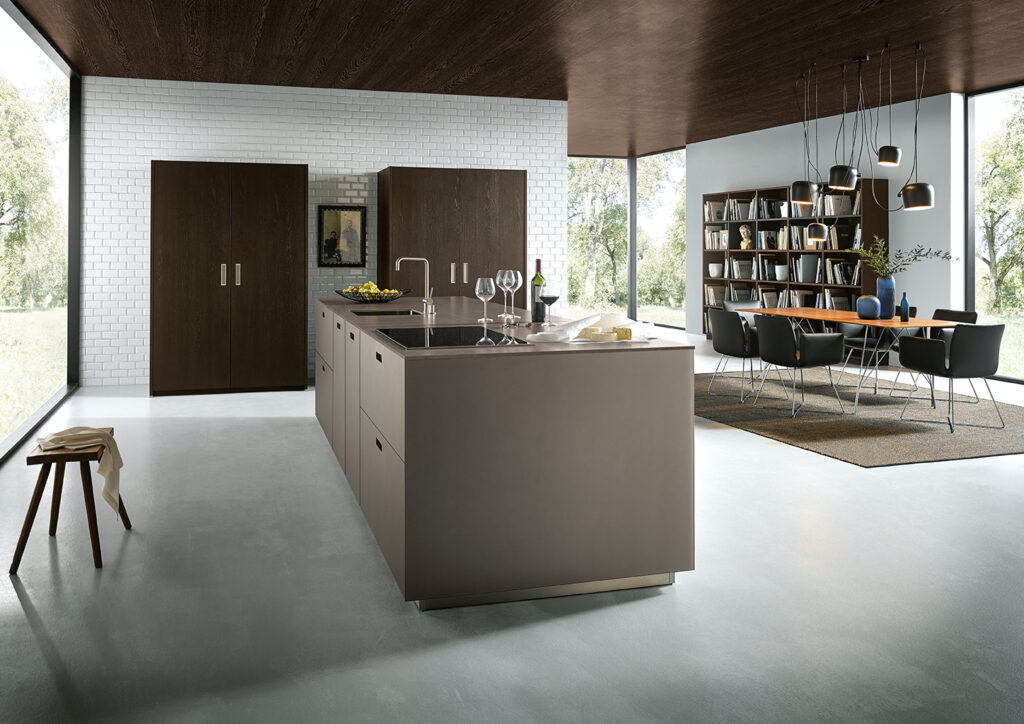
Perhaps one of the staples of luxurious kitchen design, an island is a must-have for any large space. These freestanding cabinets are handy for extra storage and worktop space and can act as an added entertaining zone, dining area, or workspace.
An island kitchen isn’t a distinct layout in and of itself. In most cases, one of the popular kitchen layouts — such as a one-wall kitchen, galley kitchen, U-shaped, or L-shaped kitchen — will be enhanced with the addition of an island. With the right design, an island can be both a practical space and a standout feature in your room.
When designing a kitchen island, consider what kind of purpose it will serve. For example, if you already have a dining area, you can use your island for storage, installing open shelving and drawers to give you plenty of space for your extras. You could also think about installing your hob in the island to allow you to cook and socialise at the same time.
If you’d like to use your kitchen island as a dining space, then the arrangement of your counter stools is important to consider. Placing your stools in one straight line can be the simplest and most attractive option but may not be the most practical for large families. If you’ll be having more than three stools, wrapping your seating area around the island, rather than sitting them in a row, can make the space feel more open and sociable.
Above all else, don’t be afraid to go bold. Kitchen islands can be a feature all on their own, and they can be great for introducing new colours or materials into your kitchen.
Peninsula kitchen
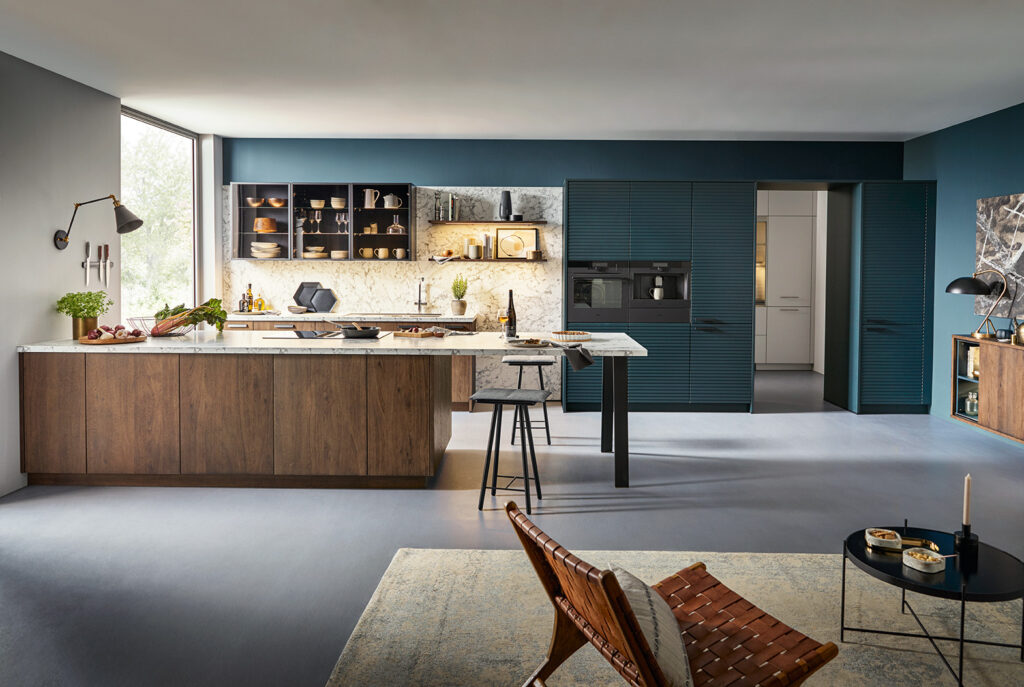
How to divide an open plan living room kitchen
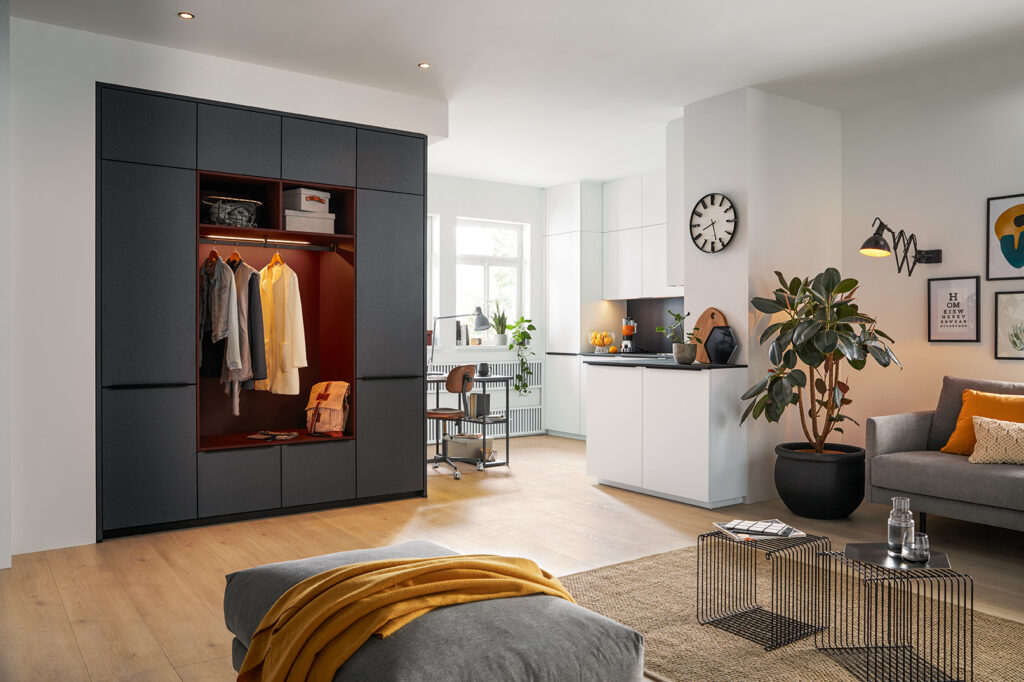
An open plan layout is the preferred option of many designers and homeowners for a reason. Not only are they incredibly spacious, but they’re also much more accessible. However, sometimes we still long for broken plan living. If you’re wondering how to design a living room with an open kitchen while still creating distinct zones, there are a few little tricks you can try.
One option is to install a peninsula kitchen, which uses an island counter to separate the kitchen space from the living space. In a similar vein, you can use furniture such as chairs, sofas, a bookcase, or a folding screen to zone off your areas.
If you’re looking for a more subtle option, wall décor, floor rugs, and different flooring effects can be perfect for creating the illusion of separate spaces. Choosing different but complementary colour schemes, patterns, and materials in each area can also help make the spaces feel like their own distinct areas.
Follow building regulations
In most cases, you won’t need to seek planning permission if you’re remodelling your kitchen. However, you may need building regulations approval for plumbing or electrical wiring that will form part of the work.
If you’ll be building a kitchen in a new extension, then you may need planning permission from your local council, along with building regulations approval. You can find out more about planning permission, including how to apply, on the Planning Portal.
Choose your kitchen
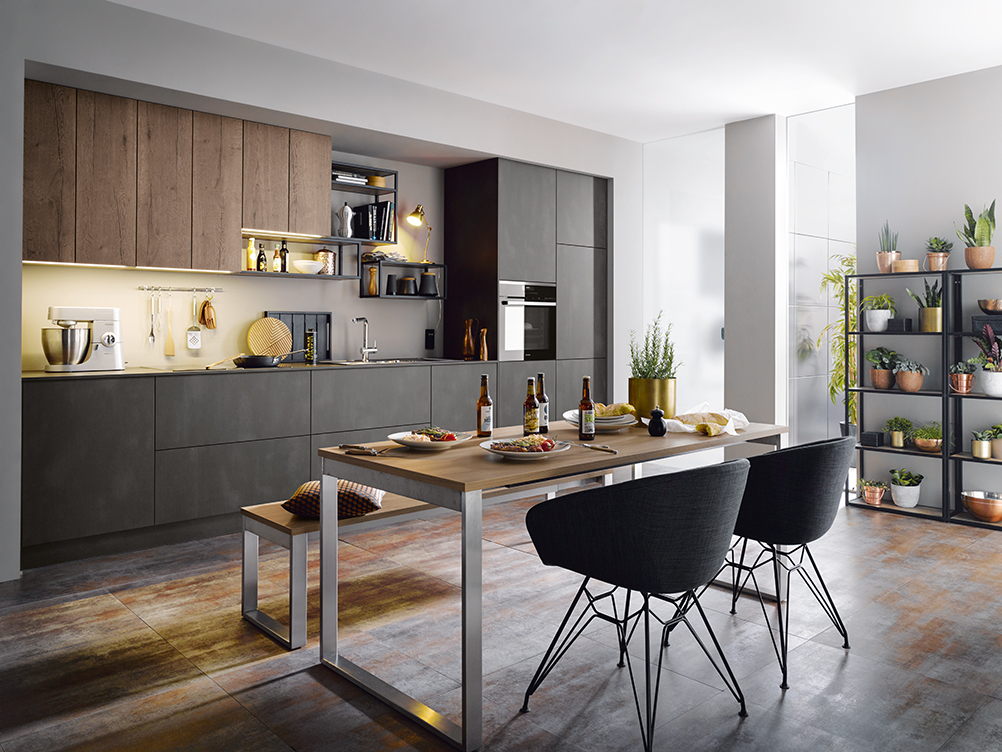
Once you’ve got the layout planning down, it’s time to start focusing on the design element. Picking each element of your kitchen may seem like a daunting task, but breaking it down into simple steps can make it easier to choose a kitchen that suits you.
Find your style
While a kitchen remodel may be on the cards for reasons of space or practicality, aesthetics naturally play an important role. There are so many different styles of kitchen out there, from modern to traditional, and matt to high gloss, that it can be tricky to decide exactly what style to incorporate into your kitchen.
The first step is to take a look at the rest of your interior décor, as your existing furniture should give you a good indication of what style you like to decorate with. Choosing a style similar to that of the rest of your furnishings helps ensure a cohesive look — something that’s particularly important in an open plan space.
The kitchen is the heart of the home. It’s where you probably spend the majority of your time, so you no doubt want to feel uplifted while you’re in it. Choosing décor that you love and incorporating patterns and colours that bring you joy are perfect ways to create a kitchen space that feels ‘you’ and that you’ll enjoy being in at all times of the day.
Taking a look at pictures online can also help you narrow down exactly what kind of kitchen you’d like to go for. Here at InHouse Inspired Room Design, we have a beautiful collection of kitchen design ideas to inspire you.
Choose your cabinetry
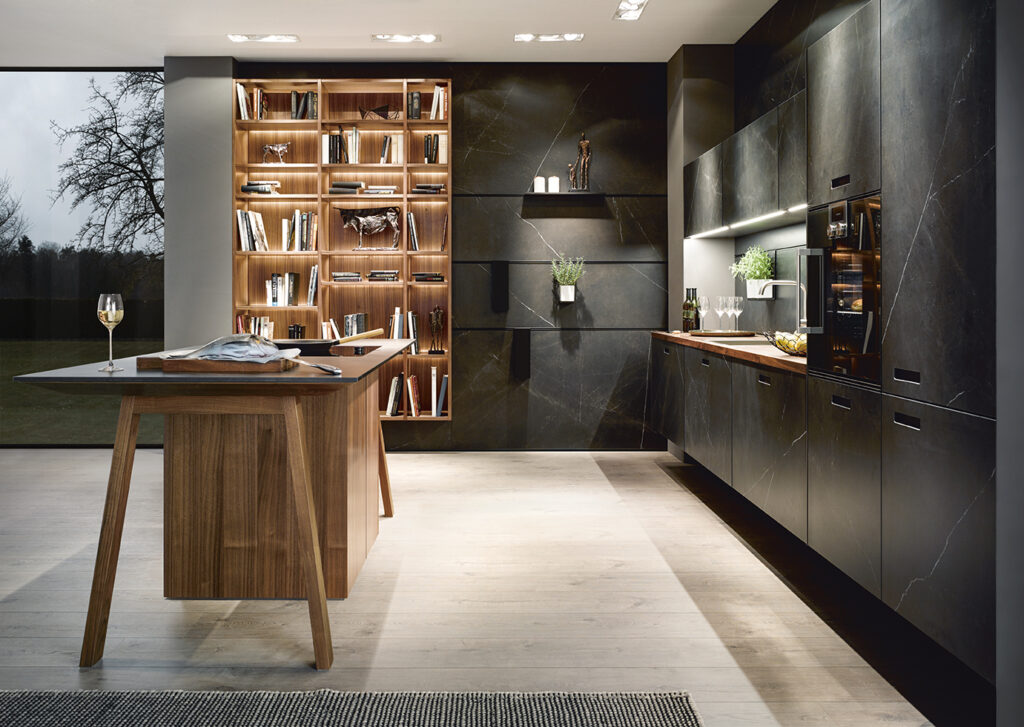
Your cabinets are the foundation of your kitchen, so making the right choice of colour and style can have a major impact on its overall look. If you love the idea of a traditional kitchen, then you may want to opt for shaker style fronts. Meanwhile, sleek high-gloss and matt cabinets are perfect for creating a minimalistic, modern look.
When choosing your cabinets, it’s important to consider the practicalities of your kitchen. For example, high gloss is perfect for ultra-modern kitchens but can show marks very easily. For this reason, it may not be the best choice for families with young children, when sticky fingerprints are common. If you’re really committed to the high gloss look, then you could opt for glass kitchen cupboards instead. These have a top layer of reinforced glass which is not only easy to clean but is incredibly durable too.
Your handles are another vital element to consider when it comes to cabinetry. Will you opt for statement handles or the simplicity of a handleless kitchen? You may also benefit from touch-to-open drawers and cupboards. These work by applying just a small amount of pressure, so are perfect if you tend to get messy in the kitchen. You can say goodbye to dirty door handles, as you can easily open and close cupboards with a little leg, elbow or shoulder bump when your hands are dirty. To find out more about this kitchen style, just take a look at our guide to handleless kitchens and how they work
Your colour scheme is also an important factor to consider. Bold cabinetry can look impressive and add personality to your space. But if you’re thinking of selling your home sometime in the near future, it may be wise to go for a more universal style.
Consider extra features
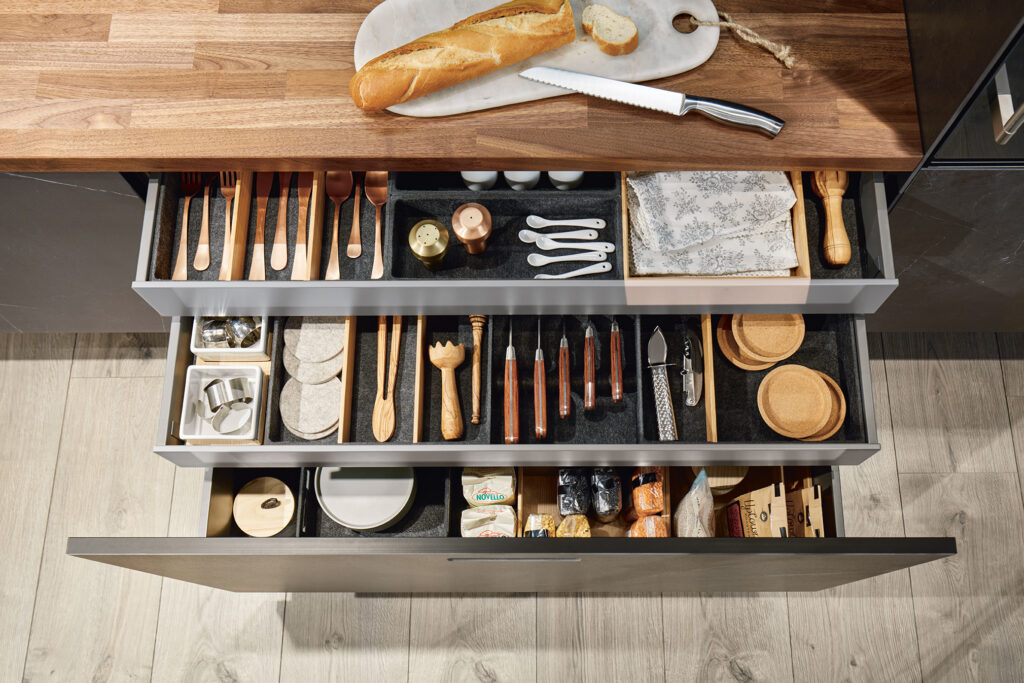
When planning a new kitchen from scratch, you have the opportunity to add extra features that you may never have considered. Many kitchen manufacturers offer extra options such as space-saving storage solutions. Narrow pull-out drawers can make use of small spaces that would otherwise go to waste. Meanwhile, installing a lazy Susan can help make those deep corner cupboards much more accessible.
If your kitchen has any awkward areas, there may very well be a solution for you, so it’s worth discussing with your kitchen designer all the options that are available. Our Schüller and next125 kitchens offer a variety of designs that are totally flexible, and our team of expert designers can help you figure out the best plan for you. Just get in touch today to book your design appointment.
Add your worktops
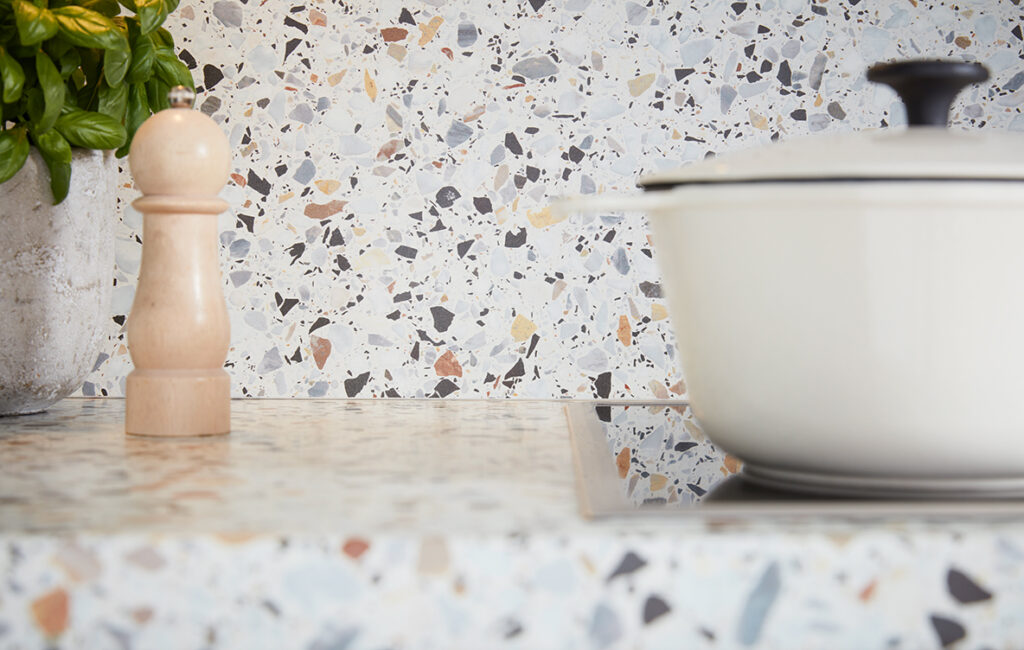
Along with cabinetry, your worktops are another essential element of kitchen design. There’s a whole range of worktops available, with different materials offering various features.
Granite: Perhaps one of the most popular worktops around, granite is hard-wearing, easy to clean, and heat resistant. It’s also antibacterial, making it the perfect choice for a kitchen. However, granite worktops can be more costly than other options.
Marble: Marble worktops can add a touch of luxury to both modern and traditional style kitchens. However, they tend to be less durable than granite — and more expensive too.
Quartz: Just like granite, quartz worktops are easy to clean, antibacterial, and hard-wearing. Quartz is also available in a wide range of colours, so you’re bound to find a material that matches your cabinetry. However, they aren’t as tolerant to heat as granite.
Wood: Wooden worktops are a stylish option, particularly in farmhouse kitchens. The natural grain of wood can add an organic uniqueness to your space that you often won’t get with other types of worktops. Plus, they’re often cheaper than stone. However, wooden worktops can be trickier to look after as they can stain fairly easily.
Laminate: If you love the look of stone or wooden worktops but are searching for something less costly or easier to care for, then laminate might be the best option for you. These surfaces can be made to look like more expensive options, plus they’re durable, heat-resistant, and can be wiped clean.
Glass: Glass worktops can add a sleek look to your kitchen, with the extra benefit of being easy to clean. However, due to their shiny surface, they can require cleaning more often. If you don’t mind the upkeep, glass worktops are a great option.
Ceramic: Marble and granite worktops look stunning but can be expensive. If you want to get the look without the price tag, you may prefer ceramic. These can be made to look like marble but are less costly. However, they do tend to be less durable than the real deal.
Not only are the style and material of your worktops important, but the colour of your counters is also vital. In most cases, the size of your kitchen can be a good place to start when choosing your worktop colour. Light worktops can make a space feel bright and airy, while dark worktops add a luxurious touch to your kitchen but can darken it.
If you have a small kitchen or a space that doesn’t get a lot of natural light, then a light-coloured kitchen with white worktops and cabinets can help open up the space. If you have a large kitchen with plenty of light, then a dark palette won’t look out of place. Don’t be afraid to mix and match your tones and colours too.
You might also want to consider which specific colours would go well with your cabinetry. For example, you may want to opt for a marble-effect worktop with a grain that reflects the same colours as your cabinet fronts. Or you could look at the undertones of your cabinetry and match those. The grey-brown undertones of cashmere cabinets can look great with dark and light grey worktops, for instance.
Select your tiles

In a kitchen, your tiles and backsplash are just as important as your cabinets. Not only do they serve a practical purpose, but they can also add an extra touch of style. There’s a whole range of tiles available, from traditional Victorian styles to bold Moroccan designs, and ceramic tiles to marble options. You’re bound to find a look you love and most, if not all, tiles are suitable for kitchens. However, the material you go for can depend on a few factors.
Natural stone
Natural stone tiles can be an expensive choice due to the fact that they must be quarried. They also need to be treated to protect the finish. Natural stone can also be more difficult to clean, requiring specialist cleaning products to keep them looking at their best. However, the natural, rugged look of these materials can add a beautiful organic touch to your kitchen, so they can definitely be worth the investment. If you love the look of natural stone, some options include:
Marble: Marble tiles are perfect if you’re looking for a clean, polished look. Available in a range of colours, from bright white to striking black. Thanks to the veining in marble, the variety is vast, ranging from subtle and delicate to bold and dramatic.
Limestone: Limestone is perfect for a sleek yet natural look, coming in a range of grey, cream, and beige hues. It’s very hardwearing, which makes it a popular choice for kitchen flooring, and it doesn’t need to be treated before laying.
Granite: Granite is a popular choice in kitchens for a reason. It’s stunning, durable, and resistant to staining, making it the perfect choice in kitchens. The most popular style is polished granite with its shiny surface, however other finishes are also available, including sleek matt and brushed options.
Slate: The natural layered effect of slate makes it an attractive feature for the kitchen. Available in various grey tones, they can add a subtle dramatic effect to any space. It’s also perfect for both walls and floors, creating a rustic yet modern look.
Travertine: Most commonly found in beige tones, although grey tones are available, travertine has a naturally uneven appearance that can add an edge to your kitchen walls. This is the option to get if you’re looking for the true natural stone look.
Manmade tiles
Manmade materials such as ceramic, glass, and porcelain tiles can be a little cheaper than their natural alternatives. They’re also available in a wide choice of designs and styles, making them the most versatile option if you’re wanting to make your tiles a feature. Synthetic tiles can also be made to mimic the look of natural stone, so you can have a low maintenance surface without compromising on style.
As with natural stone, manmade tiles can have different features depending on their material.
Ceramic: Made from baked clay, ceramic tiles are both durable and easy to care for. Strong and sturdy options can be used for floors, but thin, decorative ceramic tiles are best suited for walls.
Porcelain: Porcelain is fired to a higher temperature than ceramic during the manufacturing process, which makes it a little stronger. Due to its durability, porcelain is a great option for both walls and floors.
Glass: Glass tiles are a popular option for backsplashes thanks to their stain resistance. They can easily be wiped clean and come in a whole range of colours that can add a subtle dash of personality to your space. You’ll also commonly find them in the form of beautiful mosaic tiles.
Concrete: Concrete is also a popular choice in modern kitchens. This material is easy to care for, incredibly durable, and can look extremely effective too. Concrete-effect tiles are also available, which are usually made from porcelain.
Pick your flooring
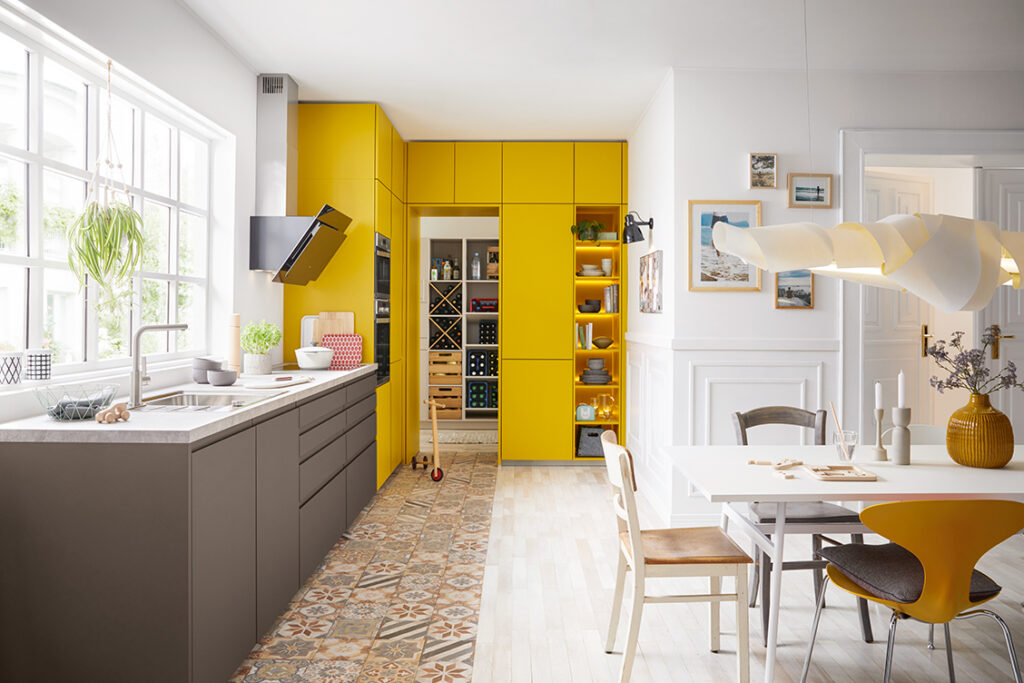
When it comes to choosing kitchen flooring, durability and ease of care is key. You’ll want something that can withstand high traffic and handle regular cleaning. Wood flooring is a popular choice thanks to its hardiness, and you can get a wide range of options that are stain and scratch-resistant, making them perfect for kitchens.
Stone is also a popular choice in kitchens and is particularly suited to traditional style spaces due to their rustic look. Some materials, such as granite, limestone, slate, and travertine, are perfect for kitchen flooring thanks to their durability. However, natural stone can feel cold underfoot. If you go for this option, you may want to consider installing underfloor heating too.
Vinyl is another great option for kitchens and comes in a wide variety of designs, from wood and stone effects to colourful tile-effect floors. Made from PVC, they’re hardwearing and easy to clean, so they’re perfect for particularly busy homes. The downside is that wood-effect vinyl flooring can have a ‘fake’ appearance. If you’re looking for a more realistic wooden option without using real wood, then laminate may be a good choice.
Add lighting
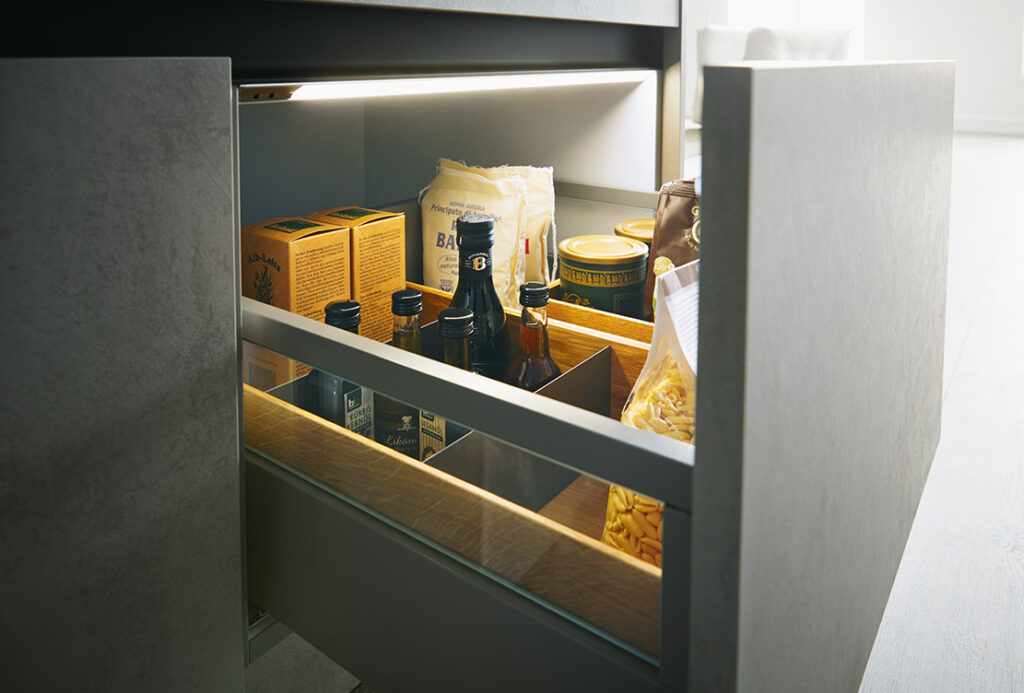
Once you’ve designed the main elements of your kitchen, it’s time to add the finishing touches. Clever lighting can give any kitchen an instant wow factor, so be sure to take time to consider which options are right for your space.
Your first stop is accent lighting. This is your main overhead light source. Spotlights are a popular option in kitchens as they’re unobtrusive, but interesting pendant lighting above islands and dining tables can become a stunning feature.
Aside from your ambient lighting, it’s also a good idea to consider task and accent lighting. Under-counter lighting can illuminate your all-important cooking tasks, while in-counter lighting can help make finding things inside your cupboards and drawers much easier.
In a kitchen, some lighting options, such as under cabinet lighting and island pendant lights, can also double up as accent lighting. If you’d like to add an extra finishing touch, plinth lighting can look incredibly effective in modern kitchens. By installing LED light strips or spotlights to your kickboards, you can illuminate your kitchen from the ground up.
When choosing lighting options for your kitchen, be sure to opt for LEDs. Not only are they more energy-efficient, but they’re also longer lasting than other bulb options, which makes them ideal for awkward areas where replacing them can be difficult. There’s also the added benefit of immediate illumination. Unlike fluorescent bulbs, LED lights are at their full brightness as soon as they’re turned on, meaning you can get on with your cooking right away.
Designing a new kitchen can be incredibly exciting, but it can feel a little daunting in the beginning. Our checklist and ideas above will help you through the process, from planning your kitchen layout to choosing your cabinets, tiles, and flooring, so you can get started right away.
Here at InHouse Inspired Room Design, we’re dedicated to making your home as beautiful and practical as possible. Our expert design team can show you how to plan a kitchen that’s perfect for you, so be sure to get in touch today.
If you’re looking for more design inspiration, head over to our kitchen ideas section, where you’ll find stunning Schüller and next125 kitchens styled by the experts. You can get the same look in your home too by shopping our collection of German kitchens today.

